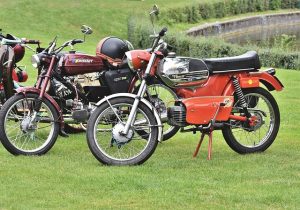When purchasing a moped for sale, it's important to consider various legal aspects including age restrictions (you must be at least 16 years old), the need for a valid driver's license (typically a Class E or equivalent), and mandatory safety certifications to ensure the vehicle meets safety standards for brakes, lighting, and noise levels. Depending on where you live, insurance may be legally required with minimum coverage varying by state, and it's recommended to also consider additional coverage for comprehensive and collision protection. Sellers looking to advertise their moped for sale must ensure proper registration with the Department of Motor Vehicles (DMV), including submission of a registration application, odometer reading, and previous damages disclosure. Additionally, buyers should research their local state laws to understand insurance requirements and age restrictions, and be aware that there are different legal distinctions between mopeds and motorized scooters which may affect their operation and classification under the law. Always verify these details to ensure a lawful and safe experience with your new moped.
navigator’s guide to understanding moped licensing requirements is essential for both prospective moped owners and riders. This article demystifies the legal landscape of mopeds, offering clarity on their classification, legality by region, and how they differ from motorcycles within various jurisdictions. Whether you’re considering mopeds for sale or are a seasoned rider, this comprehensive guide covers all aspects of registration, insurance mandates, age restrictions, safety certifications, and title and license plate processes. It also addresses the nuances of local ordinances and moped-specific laws to ensure compliance and safe operation on public roads. With this information at your fingertips, you can confidently navigate the world of mopeds with ease and legality.
Understanding Moped Classification and Legality by Region

When exploring moped options, whether from mopeds for sale listings or in showrooms, it’s crucial to grasp the classification and legal status of these vehicles by region. Mopeds, often categorized as motorized bicycles with pedals and electric-assist capabilities, navigate a unique space within transportation laws. Their classification varies across states and countries, influencing how they are registered, licensed, and operated. For instance, in some regions, a moped may be defined by its engine size, top speed, or whether it can be propelled by pedal power without motor assistance. These specifications determine if a moped is subject to the same regulations as motor vehicles or cycling laws.
Prospective buyers considering mopeds for sale should research local legislation to ensure compliance with legal requirements. This includes understanding whether a driver’s license is needed, what age restrictions apply to riders, and if there are any licensing plates required. Regulations can also dictate where mopeds can be operated—on roads, bike paths, or both—and at what speeds they must adhere. As such, the legality of a moped isn’t just about its make or model but also about understanding the nuances of local transport laws. This due diligence is essential for safe and legal operation, ensuring that riders can enjoy their mopeds without encountering legal hurdles or endangering themselves and others on the road.
Key Differences Between Mopeds and Motorcycles in Legal Frameworks

When exploring mopeds for sale, it’s crucial to understand the key differences in legal frameworks that distinguish mopeds from motorcycles. Legally, a moped is defined by its power output and maximum speed, often capped at 30-40 miles per hour, and typically equipped with pedals that can be used for propulsion. This pedal-assist feature sets mopeds apart, as many jurisdictions classify them as bicycles with motorized assistance rather than traditional motor vehicles. In contrast, motorcycles are categorized based on their engine size and performance capabilities, which usually exceed the limits of mopeds. The licensing requirements for operating a motorcycle are more stringent, often mandating a specific type of endorsement or license due to the higher risk associated with two-wheeled vehicles.
The regulatory distinctions extend beyond licensing; they also affect insurance coverage, age restrictions for riders, and even where mopeds and motorcycles can be registered and operated. For instance, mopeds might not require the same level of insurance or annual inspection as motorcycles do. Additionally, in some areas, mopeds are allowed on bike paths and may be exempt from certain road registration requirements, whereas motorcycles are bound by different rules that reflect their higher speed and power. Prospective buyers interested in mopeds for sale should familiarize themselves with these distinctions, as they can significantly influence the ownership experience, including costs, restrictions, and permissions associated with each vehicle type. Understanding these legal nuances is essential for anyone considering adding a moped or motorcycle to their transportation options.
Necessary Steps for Registering a Moped for Sale

When looking to register a moped for sale within legal frameworks, it’s crucial to adhere to the specific guidelines set forth by your local Department of Motor Vehicles (DMV) or equivalent regulatory agency. The registration process ensures that each moped meets safety standards and is legally authorized for resale. Prospective sellers should begin by gathering necessary documentation, which typically includes proof of ownership, such as a title certificate, and evidence of a successful inspection. This inspection verifies the moped’s functionality, including its lights, brakes, and engine performance. Once these initial steps are completed, sellers must complete an application for registration in the seller’s name. This form may be available online or at your local DMV office. Provided all paperwork is in order and the fees are paid, the DMV will issue a registration certificate and license plates specific to mopeds. Sellers should ensure that the moped’s odometer reading is accurately reported and that any prior damages are disclosed. After registration, sellers can proceed with listing their moped for sale, confident that they have complied with all legal requirements for resale. It’s advisable to keep copies of all registration documents and maintain records of each transaction for future reference. By following these steps diligently, sellers can facilitate a smooth and legal transfer of ownership for their moped for sale.
Insurance Requirements for Mopeds Across Different States

When exploring mopeds for sale, understanding the insurance requirements specific to each state is crucial for legal compliance and safe operation. In the United States, moped regulations vary from one state to another, with a moped defined as a two or three-wheeled vehicle that can go up to 30 miles per hour and typically has pedals that can be used to propel it. Most states mandate some form of insurance for mopeds due to their classification as motor vehicles.
In states like New York, California, and Florida, moped riders must have liability insurance coverage that includes at least $10,000 for bodily injury per person, $30,000 for bodily injury per incident, and $5,000 for property damage. Some states like Arizona and Texas may not require liability insurance but recommend it as a prudent measure against unforeseen accidents or damages. In contrast, Illinois requires a minimum of $20,000 for bodily injury per person and $40,000 for the entire incident, along with property damage coverage of at least $15,000. Prospective moped owners should research their state’s requirements before purchasing a moped for sale to ensure they are fully compliant with local laws. It’s also advisable to consider additional coverage options like comprehensive and collision insurance, which can protect against theft, vandalism, or damage incurred in non-collision events. Navigating these requirements helps guarantee both legal standing and financial protection when operating a moped.
Age Restrictions and Safety Certifications for Moped Operators

When considering the acquisition of a moped, it’s crucial to be aware of age restrictions and safety certifications that govern their operation. Prospective riders must meet a specific age requirement; typically, this is set at 16 years old in many jurisdictions. This age limit ensures that operators have sufficient maturity and experience to handle the responsibilities of moped use. Additionally, riders must possess a valid driver’s license, often referred to as a Class E or equivalent, which signifies they have undergone the necessary training and testing to operate such vehicles safely.
Safety certifications are equally important. Mopeds for sale must come with, or receive shortly after purchase, a safety certification from an authorized body. This certification verifies that the moped meets all applicable safety standards, including brakes, lighting, and noise levels. Regular maintenance and adherence to these standards are essential to ensure the continued safety of the rider and others sharing the road. Prospective buyers should always check for the latest safety certifications when shopping for mopeds for sale, as regulations can vary by region. By doing so, they can enjoy the convenience and fun of moped travel while complying with important legal and safety requirements.
Title and License Plate Procedures for Newly Purchased Mopeds

When acquiring a new moped, navigating the title and license plate procedures is a critical step to ensure legal operation on public roads. Upon purchase, the initial step involves transferring the title to your name. This process typically requires submitting the necessary paperwork to the state’s department of motor vehicles (DMV), which may include the previous owner’s title, a bill of sale, proof of insurance, and a completed transfer form. Ensure that all information is accurate and that you adhere to any specific requirements set forth by your state, as these can vary.
In parallel with titling, mopeds must be registered and equipped with valid license plates. The registration process usually entails providing proof of the moped’s VIN (Vehicle Identification Number), a valid driver’s license, and adherence to any age or safety equipment restrictions. Additionally, mopeds for sale must meet specific emissions and safety standards. After registration, you will receive license plates designated for mopeds, which often come with unique specifications such as smaller size or different colors. It’s crucial to complete both the title transfer and the registration process promptly to legally ride your new moped on public roadways. Always refer to your state’s official guidelines to ensure compliance with local regulations and procedures.
Navigating Local Ordinances and Moped-Specific Laws

When exploring mopeds for sale, understanding the local ordinances and moped-specific laws is crucial for compliance and safety. Each region has its own set of regulations that dictate how mopeds can be operated legally within their jurisdiction. These regulations may include licensing requirements, age restrictions for riders, mandatory equipment such as lights and reflectors, and even speed limitations. Prospective moped owners should research the specific laws in their area to ensure they adhere to all necessary provisions before purchasing a moped. This due diligence not only safeguards the rider but also avoids potential legal complications.
In addition to local ordinances, there are laws that are tailored specifically for mopeds. These laws may vary significantly from those governing cars and motorcycles. For instance, mopeds might be subject to different registration and licensing processes, which could involve a title transfer for used mopeds for sale, while new ones might come with a manufacturer’s warranty that outlines coverage details. Additionally, understanding the distinctions between motorized scooters and mopeds within local legislation is essential, as they may have different operational parameters and legal classifications. By familiarizing oneself with these moped-specific laws, potential buyers can confidently navigate their options among mopeds for sale, knowing they are equipped to operate their chosen vehicle in compliance with the law.
